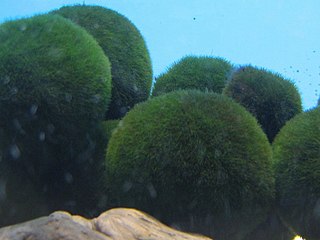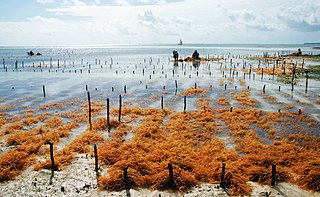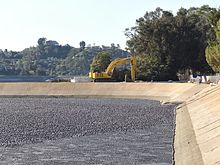
A drought is a period of drier-than-normal conditions. A drought can last for days, months or years. Drought often has large impacts on the ecosystems and agriculture of affected regions, and causes harm to the local economy. Annual dry seasons in the tropics significantly increase the chances of a drought developing, with subsequent increased wildfire risks. Heat waves can significantly worsen drought conditions by increasing evapotranspiration. This dries out forests and other vegetation, and increases the amount of fuel for wildfires.

Owens Lake is a mostly dry lake in the Owens Valley on the eastern side of the Sierra Nevada in Inyo County, California. It is about 5 miles (8.0 km) south of Lone Pine. Unlike most dry lakes in the Basin and Range Province that have been dry for thousands of years, Owens held significant water until 1913, when much of the Owens River was diverted into the Los Angeles Aqueduct, causing Owens Lake to desiccate by 1926. In 2006, 5% of the water flow was restored. As of 2013, it is the largest single source of dust pollution in the United States.

The California Water Wars were a series of political conflicts between the city of Los Angeles and farmers and ranchers in the Owens Valley of Eastern California over water rights.
The Los Angeles Department of Water and Power (LADWP) is the largest municipal utility in the United States with 8,100 megawatts of electric generating capacity (2021–2022) and delivering an average of 435 million gallons of water per day to more than four million residents and local businesses in the City of Los Angeles and several adjacent cities and communities in southwestern Los Angeles County, California.

The Los Angeles Aqueduct system, comprising the Los Angeles Aqueduct and the Second Los Angeles Aqueduct, is a water conveyance system, built and operated by the Los Angeles Department of Water and Power. The Owens Valley aqueduct was designed and built by the city's water department, at the time named The Bureau of Los Angeles Aqueduct, under the supervision of the department's Chief Engineer William Mulholland. The system delivers water from the Owens River in the eastern Sierra Nevada mountains to Los Angeles.

East Bay Municipal Utility District (EBMUD), colloquially referred to as "East Bay Mud", is a public utility district which provides water and sewage treatment services for an area of approximately 331 square miles (860 km2) in the eastern side of the San Francisco Bay. As of 2018, EBMUD provides drinking water for approximately 1.4 million people in portions of Alameda County and Contra Costa County in California, including the cities of Richmond, El Cerrito, Hercules, San Pablo, Pinole, Lafayette, Moraga, Orinda, Danville, Oakland, Piedmont, Emeryville, Berkeley, Albany, Alameda, San Leandro, neighboring unincorporated regions, and portions of cities such as Hayward and San Ramon. Sewage treatment services are provided for 685,000 people in an 88-square-mile area (as of 2018). EBMUD currently has an average annual growth rate of 0.8% and is projected to serve 1.6 million people by 2030. Headquartered in Oakland, EBMUD owns and maintains 2 water storage reservoirs on the Mokelumne River, 5 terminal reservoirs, 91 miles (146 km) of water transmission aqueducts, 4,100 miles (6,600 km) of water mains, 6 water treatment plants (WTPs), 29 miles (47 km) of wastewater interceptor sewer lines and a regional wastewater treatment facility (WWTF) rated at a maximum treatment capacity of 320 MGD.

Marimo is a rare growth form of Aegagropila linnaei in which the algae grow into large green balls with a velvety appearance.

A salt evaporation pond is a shallow artificial salt pan designed to extract salts from sea water or other brines. The salt pans are shallow and expansive, allowing sunlight to penetrate and reach the seawater. Natural salt pans are formed through geologic processes, where evaporating water leaves behind salt deposits. Some salt evaporation ponds are only slightly modified from their natural version, such as the ponds on Great Inagua in the Bahamas, or the ponds in Jasiira, a few kilometres south of Mogadishu, where seawater is trapped and left to evaporate in the sun.

The bromate anion, BrO−
3, is a bromine-based oxoanion. A bromate is a chemical compound that contains this ion. Examples of bromates include sodium bromate,, and potassium bromate,.
An atmometer or evaporimeter is a scientific instrument used for measuring the rate of water evaporation from a wet surface to the atmosphere. Atmometers are mainly used by farmers and growers to measure evapotranspiration (ET) rates of crops at any field location. Evapotranspiration is a measure of all of the water that evaporates from land surfaces plus the water that transpires from plant surfaces. Based on the amount of water that does evaporate and transpire, the user can water crops correspondingly, which results in less water use and possibly increased crop yields. Companies that currently sell atmometers include C&M Meteorological Supply and Calsense.

An urban forest is a forest, or a collection of trees, that grow within a city, town or a suburb. In a wider sense, it may include any kind of woody plant vegetation growing in and around human settlements. As opposed to a forest park, whose ecosystems are also inherited from wilderness leftovers, urban forests often lack amenities like public bathrooms, paved paths, or sometimes clear borders which are distinct features of parks. Care and management of urban forests is called urban forestry. Urban forests can be privately and publicly owned. Some municipal forests may be located outside of the town or city to which they belong.

Algaculture is a form of aquaculture involving the farming of species of algae.

Jayakwadi dam is an earthen dam located on Godavari river at the site of Jayakwadi village in Paithan taluka of Sambhajinagar district in Maharashtra, India. It is a multipurpose project. The water is mainly used to irrigate agricultural land in the drought-prone Marathwada region of the state. It also provides water for drinking and industrial usage to nearby towns and villages and to the municipalities and industrial areas of Sambhajinagar and Jalna districts. The surrounding area of the dam has a garden and a bird sanctuary.

The Silver Lake Reservoir Complex comprises two concrete-lined basins, Ivanhoe Reservoir and Silver Lake, divided by a spillway, in the Silver Lake community of Los Angeles, California.
Waurika Lake is a reservoir in southwestern Oklahoma, near Waurika. It is primarily in Jefferson County, but small parts of it are in Stephens County and Cotton County, Oklahoma. Its primary purposes are to provide flood control, irrigation, water supply, water quality, fish and wildlife, recreation, and other conservation needs of the public. The lake supplies water for the cities of Lawton, Duncan, Comanche, Temple, and Waurika. The wildlife management area comprises about 6,040 acres (24.4 km2).

The Chatsworth Nature Preserve (CNP) is a 1,325-acre (536 ha) open-space preserve located in the northwest corner of the San Fernando Valley in Los Angeles, California, United States. The preserve contains oak woodlands, savanna, riparian areas, grassland, vernal pools, and an Ecology Pond, all of which support more than 200 bird species and numerous mammals, amphibians and reptiles.

The historical and ongoing droughts in California result from various complex meteorological phenomena, some of which are not fully understood by scientists.

The 2011–2017 California drought persisted from December 2011 to March 2017 and consisted of the driest period in California's recorded history, late 2011 through 2014. The drought wiped out 102 million trees from 2011 to 2016, 62 million of those during 2016 alone. The cause of the drought was attributed to a ridge of high pressure in the Pacific Sea—the "Ridiculously Resilient Ridge"—which often barred powerful winter storms from reaching the state.

Climate change in Kentucky encompasses the effects of climate change, attributed to man-made increases in atmospheric carbon dioxide, in the U.S. state of Kentucky.
The Beacon Solar Project is a photovoltaic power station in the northwestern Mojave Desert, near California City in eastern Kern County, California. Split into five phases, the combined Beacon solar facilities generate 250 MW of renewable energy for the Los Angeles Department of Water and Power (LADWP). The five phases of the project, fully completed in December 2017, include a total of 903,434 individual solar photovoltaic modules, mounted onto Nextracker single-axis tracking systems.


















